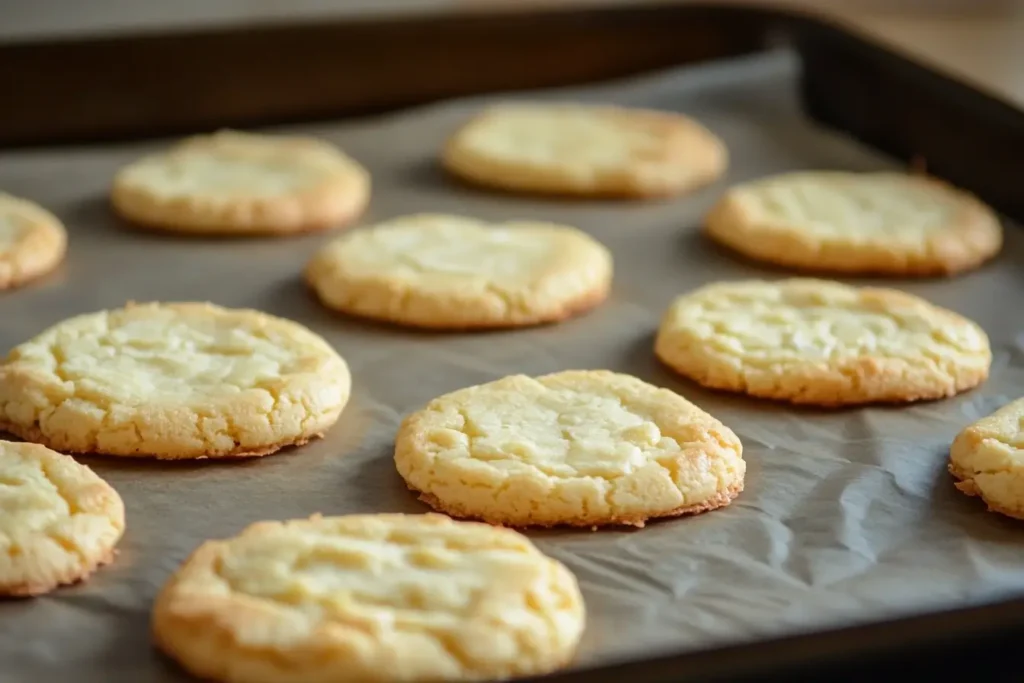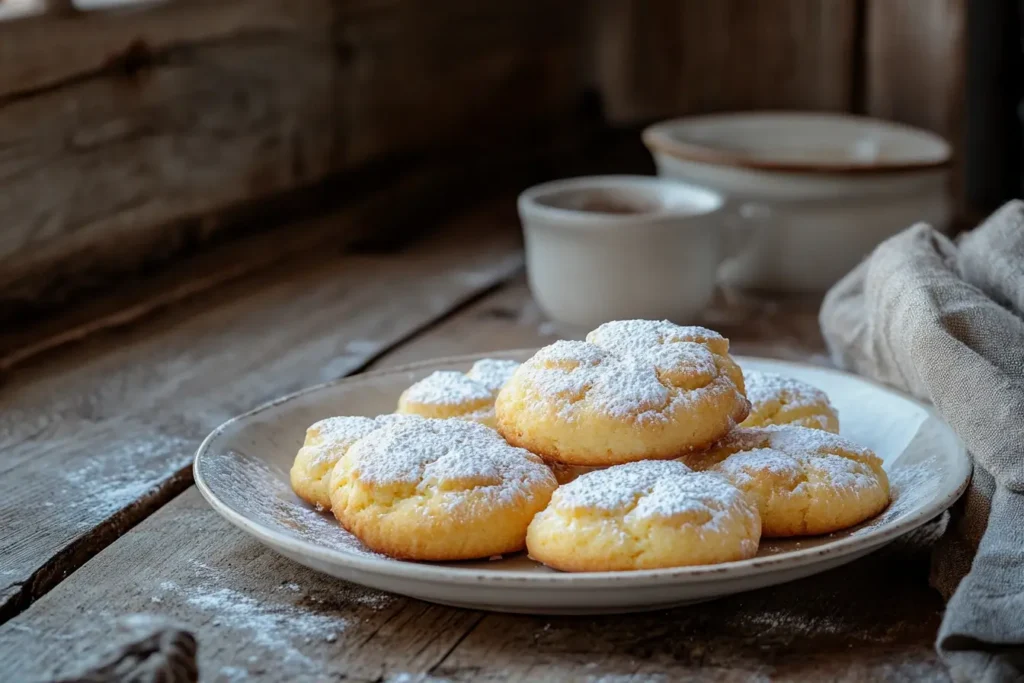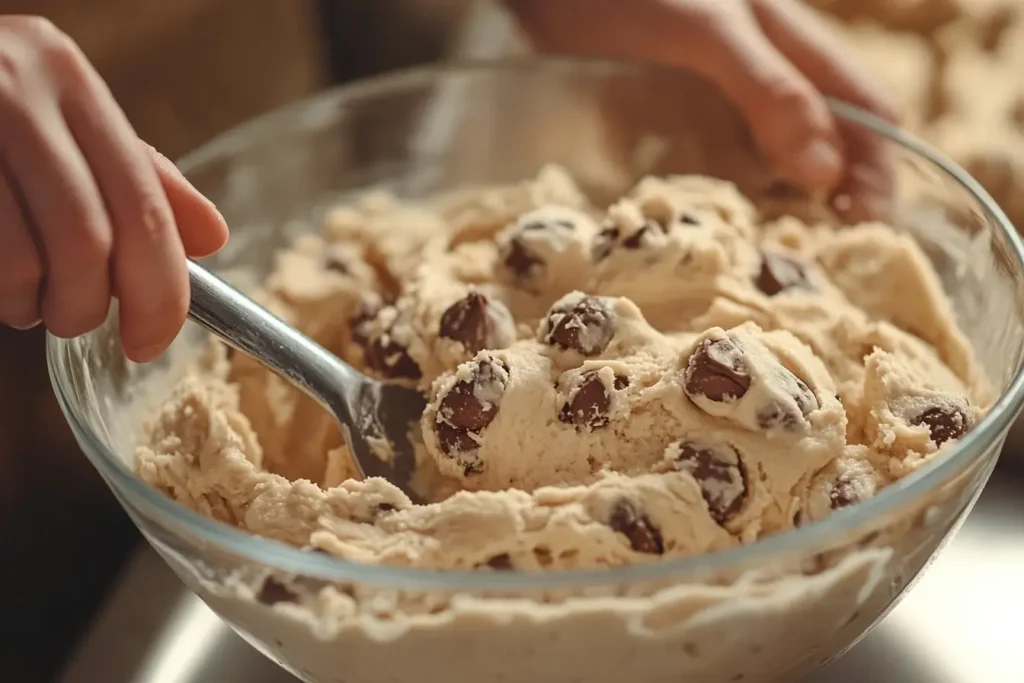Cool Whip cookies turning out flat can be frustrating, especially when you’re expecting soft, fluffy treats. There are several factors that contribute to flat cookies, ranging from ingredient ratios to baking techniques. Understanding these issues is the first step toward achieving the perfect batch of Cool Whip cookies.

Ingredient Balance:
An imbalance in the ingredients is often a key factor behind flat Cool Whip cookies. These cookies rely on a simple combination of Cool Whip, eggs, and cake mix. If the amount of Cool Whip is insufficient, the cookies might not have the structure required to rise properly. On the other hand, an excess of eggs can create a runny dough, causing the cookies to spread excessively. Maintaining the right proportions ensures that the dough holds its shape during baking.
Mixing Methods:
Another overlooked factor is the mixing process. Overmixing the dough introduces too much air, which causes the cookies to collapse as they bake. This happens because the air bubbles expand in the heat and then deflate, resulting in a flat texture. To prevent this issue, stir the ingredients just until they are fully combined. Under-mixing, however, can leave dry patches of cake mix, leading to uneven baking and flat results.
Temperature Issues:
The baking temperature is crucial for Cool Whip cookies. If your oven is too hot, the dough may spread too quickly before the structure sets. On the other hand, a low oven temperature won’t allow the cookies to rise properly. Preheating the oven to the correct temperature is essential, and investing in an oven thermometer can help you monitor accuracy. A poorly calibrated oven is a common culprit for baking failures.
Cooling Process:
The way cookies cool also affects their texture. If cookies are left on a hot baking sheet after removing them from the oven, the residual heat continues to cook and flatten them. Transferring cookies to a wire rack as soon as they firm up ensures that the bottoms do not become too soft. Avoid placing cookies in humid environments during cooling, as excess moisture can cause them to lose their shape.
Understanding the factors above can help troubleshoot why your Cool Whip cookies turn out flat. By adjusting the ingredient balance, improving mixing techniques, monitoring oven temperatures, and cooling cookies correctly, you’ll achieve more consistent and desirable results.
Understanding the Science Behind Cool Whip Cookies
To truly understand why Cool Whip cookies can turn out flat, it’s important to look at the science behind the ingredients and processes. Cool Whip, eggs, and cake mix are unique in their combination, and each element contributes to the final texture of the cookies. Small changes in these components can drastically impact your baking results.
How Cool Whip Affects Cookie Texture and Consistency
Cool Whip is a whipped topping made from oils, sweeteners, and stabilizers. Its light and fluffy consistency allows cookies to have a soft, airy texture. However, the whipped nature of Cool Whip also means it can collapse under heat if the dough lacks proper structure. This is why it’s important to add the correct amount of flour (if needed) or cake mix to help stabilize the cookie dough.
Cool Whip’s moisture content is another factor to consider. If too much Cool Whip is used, the dough will become overly wet, causing the cookies to spread and flatten during baking. On the flip side, too little Cool Whip can result in dry, crumbly cookies that fail to rise.
The Importance of Eggs in Maintaining Structure
Eggs are a key ingredient in many cookie recipes, including Cool Whip cookies, because they provide structure and binding power. The egg yolk adds fat, which contributes to a rich, tender texture, while the egg whites provide protein, helping cookies hold their shape. Adding an extra egg can make cookies slightly fluffier because it provides more protein and moisture, which helps them rise. However, adding too many eggs can make the dough too wet, leading to flat cookies that spread in the oven.
If you want to experiment with eggs, try adding only an extra egg yolk instead of a whole egg. This boosts the fat content without altering the moisture levels too much, which can help create fluffier cookies.
Dry Ingredients Like Cake Mix and Flour
Cake mix is the base for Cool Whip cookies, and it’s packed with flour, sugar, and leavening agents. Maintaining the right balance between wet and dry ingredients is essential. If too much cake mix is used, the dough can become dense and dry, making it hard for the cookies to spread properly. On the other hand, too little cake mix creates a runny batter that flattens during baking.
The flour and leavening agents in cake mix are responsible for giving the cookies their structure and rise. If you’re struggling with flat cookies, consider adding a small amount of extra flour (about 1–2 tablespoons) to help the dough hold its shape better.
Mixing and Baking Techniques
How you mix the ingredients also matters. Overmixing incorporates excess air, which causes cookies to rise quickly and then collapse. Under-mixing, however, prevents the ingredients from fully combining, leading to uneven baking. To achieve the best results, mix until the dough is just combined—no more, no less.
Baking temperature plays a significant role as well. High heat causes cookies to spread rapidly, while low heat prevents proper rising. Preheating the oven and testing its temperature accuracy are essential steps for consistent baking.
Understanding the science behind Cool Whip cookies helps you make adjustments to prevent flat cookies. By balancing moisture, structure, and temperature, you can achieve light, fluffy, and perfectly baked cookies every time.
Role of Ingredients in Cookie Structure
When baking Cool Whip cookies, each ingredient plays a specific role in determining the cookie’s structure, texture, and shape. Understanding how these ingredients interact is crucial to troubleshooting flat cookies and achieving consistent results.

The Impact of Eggs on Cookie Structure
Eggs are one of the most important components in any baking recipe because they bind the ingredients together and provide structure. Egg whites are rich in protein, which helps cookies rise and hold their shape, while egg yolks contribute fat for a soft, tender texture. If you find your Cool Whip cookies spreading too much, consider adding an extra egg yolk. This small adjustment increases the fat content without introducing too much liquid, which helps the cookies hold their shape better during baking.
However, adding too many eggs can have the opposite effect. Excess moisture can make the dough runny and cause cookies to spread thin in the oven. Always stick to the recipe proportions and adjust cautiously, especially when experimenting with eggs.
The Role of Dry Ingredients Like Cake Mix and Flour
Cake mix serves as the primary dry ingredient in Cool Whip cookies, providing flour, sugar, and leavening agents. These components work together to create structure, sweetness, and lift in the cookies. If the proportions are off—either too little or too much cake mix—your cookies will not rise correctly, a common issue when working with double chocolate chip cookies.
- Too Little Cake Mix: The dough becomes too wet and lacks the structure needed to hold its shape, causing cookies to flatten.
- Too Much Cake Mix: The dough becomes overly dense, preventing the cookies from spreading properly and resulting in hard, dry cookies.
For more control over the dough consistency, consider adding a small amount of all-purpose flour (1–2 tablespoons) if your cookies keep turning out flat. The added flour reinforces the dough’s structure without altering the flavor significantly.
How Cool Whip Affects Dough Consistency
Cool Whip is a whipped topping made from oils, stabilizers, and sweeteners. It’s a unique ingredient that provides a light, fluffy texture to the dough. However, it doesn’t behave like traditional fats (such as butter or oil), which means its consistency can be tricky to manage. If too much Cool Whip is added, the dough becomes too soft and spreads excessively.
To ensure a balanced texture, measure the Cool Whip accurately and mix it gently into the other ingredients. Overmixing can cause the Cool Whip to lose its airy structure, which contributes to flat cookies.
Achieving the Right Consistency
The key to perfectly baked Cool Whip cookies lies in achieving the right dough consistency. If your dough feels too sticky, refrigerating it for 15–30 minutes can help firm it up. Chilling the dough also slows down the spreading process, allowing the cookies to rise more evenly in the oven, as explained in keeping cookies soft: tips and secrets.
Finally, remember that ingredient freshness matters. Old cake mix or expired eggs can affect the final texture and prevent the cookies from achieving the desired height and fluffiness. Always use fresh, high-quality ingredients for the best results.
By paying close attention to the balance of ingredients, including eggs, cake mix, and Cool Whip, you can create cookies that rise evenly and maintain their shape. Small adjustments, such as adding an extra egg yolk or a bit of flour, can make a significant difference in preventing flat cookies.
Role of Mixing Techniques
Mixing techniques play a vital role in achieving perfectly shaped Cool Whip cookies. The way you mix the dough determines the consistency, texture, and structure of the final product. Both overmixing and undermixing can lead to flat, misshapen cookies, so mastering the proper method is essential.

Overmixing vs. Undermixing the Dough
Overmixing is one of the most common mistakes when baking cookies. When you overmix the dough, you incorporate excess air into the mixture. Initially, this trapped air may cause the cookies to puff up in the oven, but as they cool, the air escapes, causing the cookies to deflate and flatten. Additionally, overmixing can overwork the gluten in the flour, resulting in a tough, chewy texture rather than the desired soft, fluffy consistency.
On the other hand, undermixing the dough prevents the ingredients from fully combining. Pockets of dry cake mix or Cool Whip that are not evenly distributed throughout the dough can create uneven baking, causing some cookies to flatten while others rise. To avoid this, mix the dough until the ingredients are just combined. Once you no longer see streaks of cake mix or Cool Whip, stop mixing.
Tips for Proper Mixing
- Use a Gentle Hand: Use a spatula or a low-speed setting on a mixer to combine the ingredients. Gentle mixing ensures the dough stays light and airy without overworking the gluten.
- Scrape the Bowl: Make sure to scrape the sides and bottom of the mixing bowl to evenly incorporate all the ingredients. Missing pockets of dry mix can cause uneven results.
- Add Ingredients Gradually: Add the Cool Whip and cake mix gradually, mixing until just blended before adding more. This prevents overmixing and ensures a uniform dough.
Why Dough Consistency Matters
The right dough consistency is crucial for cookies that rise and hold their shape. Cool Whip cookies require a dough that is soft but not overly wet. If the dough feels too sticky or loose, it may spread excessively during baking. To correct this:
- Chill the Dough: Place the dough in the refrigerator for 15–30 minutes. Chilling helps firm up the Cool Whip and stabilizes the dough, reducing spreading in the oven.
- Adjust Ingredients: If the dough is too sticky, add a tablespoon of cake mix or flour at a time until it reaches the desired consistency. Avoid adding too much, as this can make the cookies dense and dry.
Achieving Uniform Cookies
Uniform cookies not only look better but also bake more evenly. To ensure consistent size and shape:
- Use a cookie scoop or spoon to portion the dough evenly. This prevents some cookies from baking faster than others.
- Lightly grease or line your baking trays with parchment paper to prevent sticking and ensure even baking.
Mastering the right mixing technique will help you avoid common mistakes like overmixing, undermixing, or uneven dough consistency. By using a gentle hand and chilling the dough when necessary, you’ll achieve light, fluffy cookies that maintain their shape and texture every time.
FAQ Section
Why Did My Cool Whip Cookies Turn Out Flat?
Flat Cool Whip cookies are often caused by incorrect ingredient measurements, improper mixing, or baking at the wrong temperature. Overly warm dough or an uncalibrated oven can also lead to excessive spreading. Chilling the dough and ensuring accurate measurements can help prevent flat cookies.
How Do I Keep My Cookies From Going Flat?
To avoid flat cookies, try these tips:
- Chill the dough for 15–30 minutes before baking.
- Use parchment paper or a silicone baking mat to control spreading.
- Verify that your oven is calibrated to the correct temperature.
- Avoid overmixing the dough to prevent excess air from deflating the cookies.
How Can I Make My Cookies Fluffier Instead of Flat?
For fluffier cookies:
- Add 1–2 tablespoons of extra cake mix or all-purpose flour to stabilize the dough.
- Include an extra egg yolk for richness and structure.
- Chill the dough thoroughly before baking.
- Bake at a slightly higher temperature (375°F/190°C) to help the cookies rise faster.
What Does Adding an Extra Egg Do to Cookies?
Adding an extra egg can enhance the cookies by:
Contributing to a fluffier and more tender result.
However, too many eggs can make the dough overly wet, so balance the other ingredients accordingly.
Increasing moisture for a softer texture.
Improving structure, helping cookies rise and hold their shape.
Conclusion: Mastering Cool Whip Cookies
Baking the perfect batch of Cool Whip cookies requires understanding the balance of ingredients, proper techniques, and careful monitoring of the baking process. Flat cookies can often be traced to factors like ingredient proportions, mixing methods, or temperature issues—but with the right adjustments, you can consistently create light, fluffy, and beautifully shaped cookies.
By applying the tips and solutions outlined in this guide, you’ll not only prevent flat cookies but also master the art of baking Cool Whip cookies that delight every time. With a little practice and attention to detail, you can turn this simple recipe into a staple that your friends and family will love.
